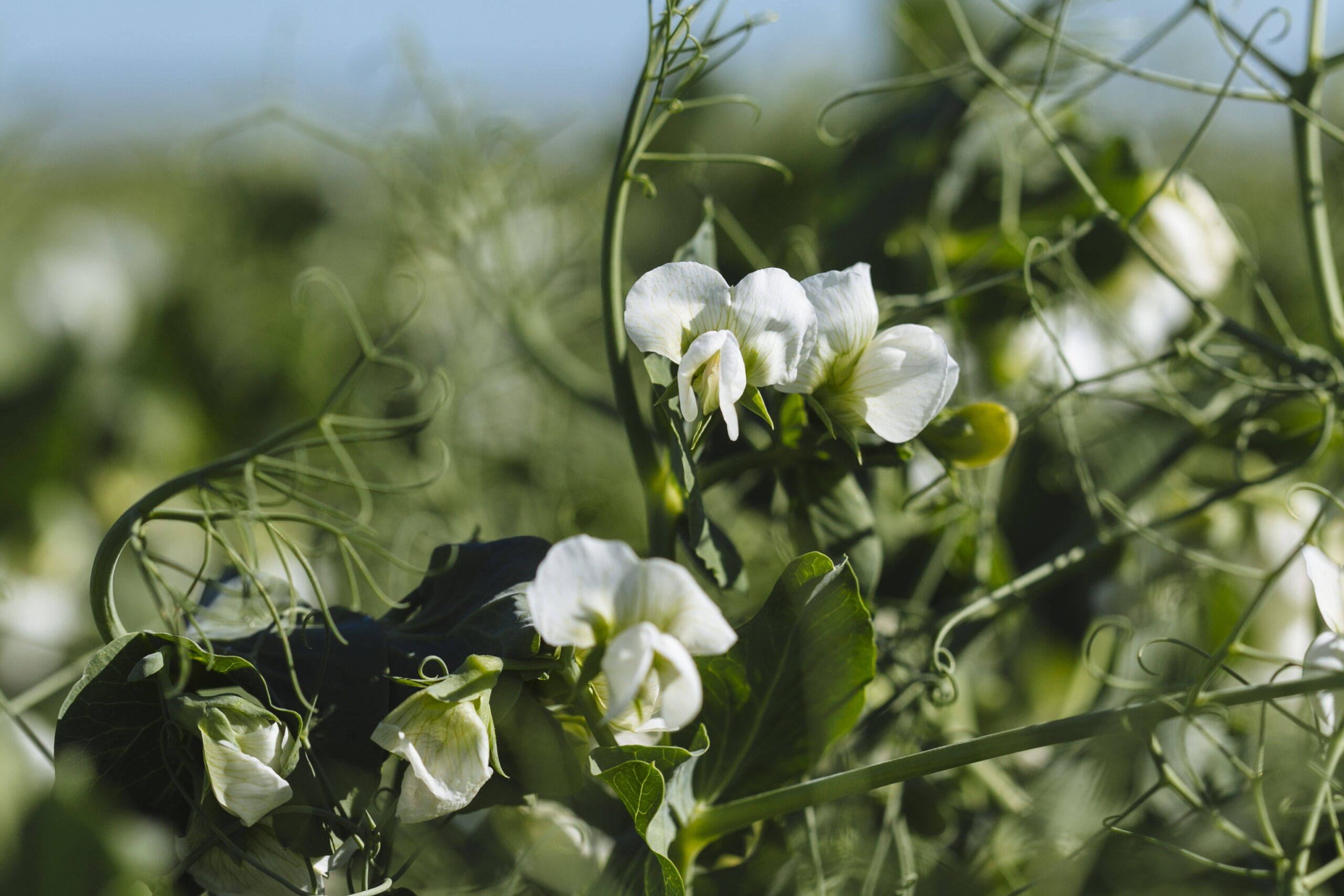Weed Management
Peas are not a competitive crop, so good weed management is essential. An integrated approach to weed control combines preventative and cultural measures (such as the use of clean, healthy seed, crop rotation, and proper seeding rates), with the effective use of herbicides. Weed management for pea crops should also be considered in the year prior to growing peas. Grow a rotational crop that provides good competition to weeds, allows for a wide range of herbicide options, and is easy to control as a volunteer in the following pea crop. Managing perennial weeds, knowing your field’s weed history, and anticipating in-crop weeds are keys to a successful weed control program.
An application of pre-harvest glyphosate in the previous year’s crop, fall herbicide application for winter annuals, and selection of a field that has weeds that may be controlled culturally or with herbicides registered for use in peas, are important points to note when planning pea production. Avoid areas where perennial weeds such as Canada thistle or sow thistle may be a problem. Peas are susceptible to the soil residues of some herbicides used in previous years.
A spring herbicide application, either pre-seed or pre-emergent, is recommended. This provides early-season weed control and may provide control of weeds for which no in-crop control is available. Peas may be slower to emerge, allowing more time if a post-seed/pre-emergent herbicide application is planned. However, with good growing conditions and shallower seeding, emergence can be more rapid, so timing must be watched closely.
Herbicide Resistant Weeds
Herbicide choice should consider the rotation of herbicide modes of action to slow the development of resistant weeds. Resistant weeds can have an impact on pea crops simply because peas are a less competitive crop and there are limited herbicide options. A few examples of herbicide-resistant weeds that are particularly troublesome for pea growers include Group 2 resistant kochia, wild mustard, and cleavers, as well as Group 1 and Group 2 resistant wild oats. Rotating herbicide groups away from Group 1 and 2 products, especially in rotational years where peas are not grown, can help prevent or manage resistant weeds. Research indicates that alternating between two modes of action for wild oat control will double the number of years for resistance build-up, and alternating with a third mode of action will increase the time of resistance build-up to four times as long as for a single mode of action for wild oat control. Applying mixtures of herbicides with multiple modes of action at the same time, where products are active on the same weeds of concern, is one of the most effective means to slow the development of herbicide resistance.
Timing of Application
The timing of herbicide application is very important with peas. Earlier herbicide application means weeds are well-exposed, are smaller (generally weeds are easier to control at a younger stage), and the crop is less susceptible to injury. Research in northeast Alberta and the Peace River region showed pea yields were higher and more consistent with the application at the second node stage compared to the eighth node stage. Yield was increased (22–125%) seven times out of 10 with early applications. Research conducted at Agriculture and Agri-Food Canada (AAFC) and Agri-ARM Sites in Saskatchewan also demonstrated the importance of early weed removal in pea production. Annual weeds were removed from pea crops at intervals of one, two, three, and four weeks after crop emergence. Pea yields did not decline after one week, declined 7% after two weeks, 12% after three weeks, and 26% after four weeks.
Minimizing Crop Injury to Herbicides
During periods of crop stress (heat, drought, frost, or after land rolling) the ability of the pea crop to tolerate herbicide application may be reduced. Crop injury can be reduced by waiting approximately four days after the crop stress occurs before applying herbicide, by maintaining water volumes at label recommendations, and by applying the product during the evening.
Peas can be damaged easily by some herbicides registered for other crops. Sprayer tanks should be thoroughly cleaned before applying any crop protection product to pea and care taken to avoid the drift of herbicides from other fields onto pea fields.
Alternatives to Chemical Weed Control
Non-herbicide weed control options may be considered as well. Tillage may have a beneficial effect for control of some weeds while having the opposite effect on others. Tillage may be a tool to reduce kochia populations. Kochia appears well adapted to no-till with germination beginning at 50 cumulative growing degree days (well before other common weed species). The burial of kochia seed to at least 1 cm or deeper can result in reduced germination or death of the germinated seed prior to emergence. Tillage to bury kochia seed should not be overlooked as a part of an integrated weed strategy for kochia control. However, this has limited value where minimum or no-till is practiced.
Rod-weeding five to seven days after seeding provides excellent weed control without herbicide use, and good tolerance to peas seeded 7.5 cm (3 in) deep. Tillage 10 to 12 days prior to seeding helps stimulate weed growth for control with the rod-weeder.
Harrowing between seeding and emergence of the pea crop can control newly emerged weed seedlings and remove weeds that escaped previous tillage operations. Harrowing should be avoided during crop emergence and for several days afterwards, to permit effective rooting and stand establishment. Post-emergence harrowing has been researched at the AAFC Research Station at Scott, Saskatchewan. Peas were found to be somewhat tolerant to post-emergence harrowing. A higher seeding rate should be used to offset the plant losses due to harrowing. Post-emergent harrowing should be done under warm, dry conditions to improve weed control and prevent the spread of diseases.
Related Resources
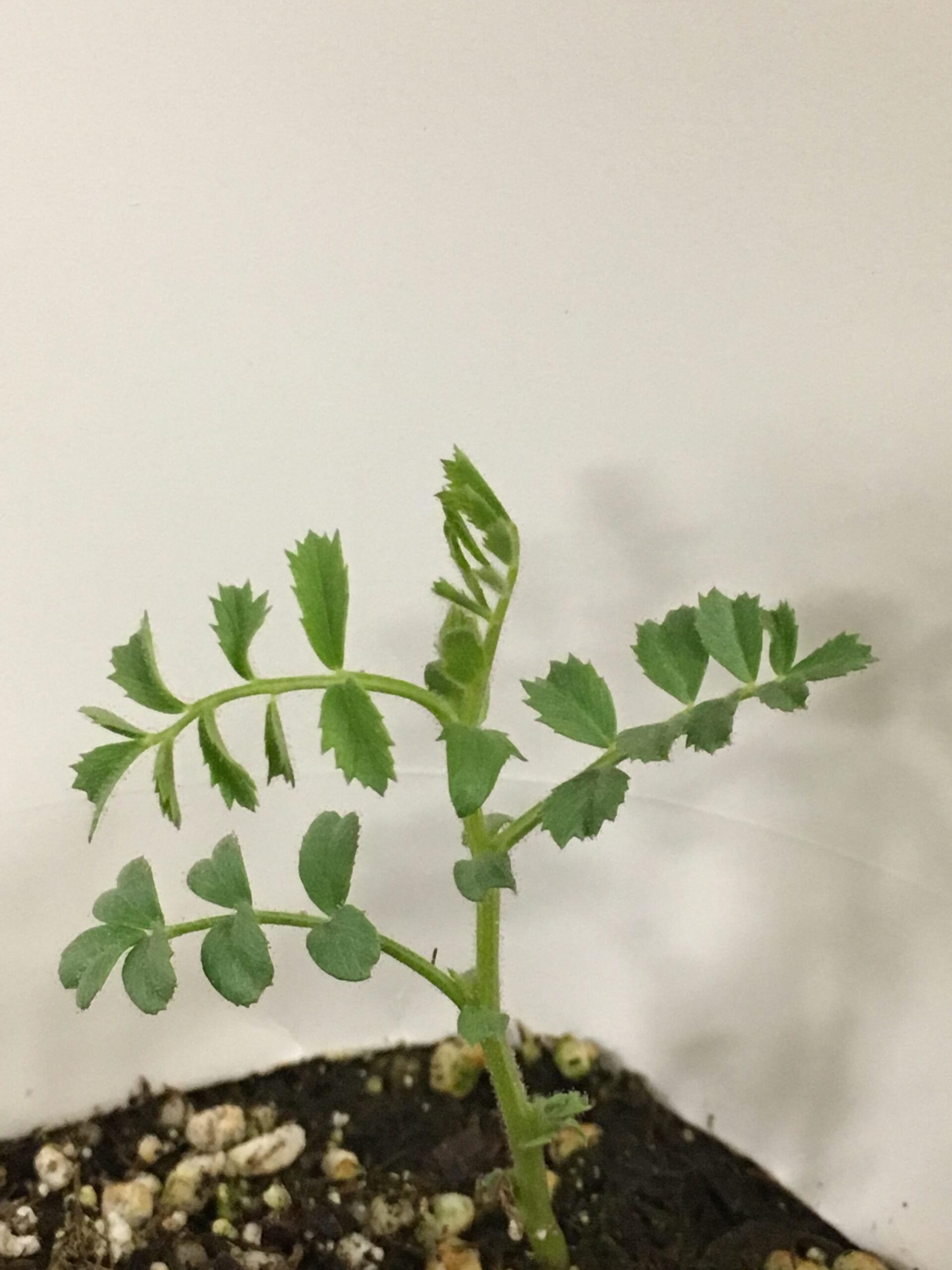
Staging Pulses for Herbicide Applications In-Crop
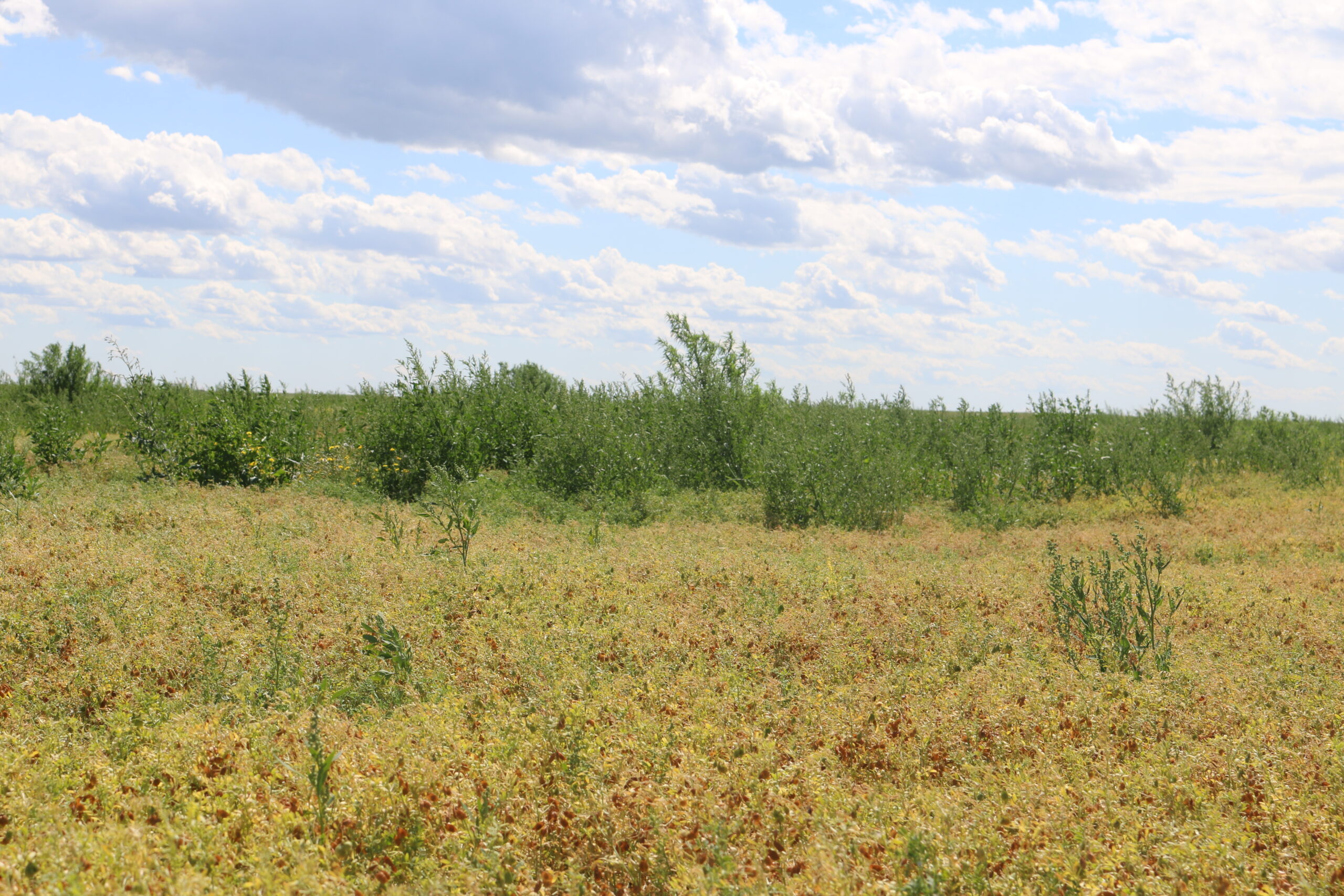
Critical Period of Weed Control in Pulses
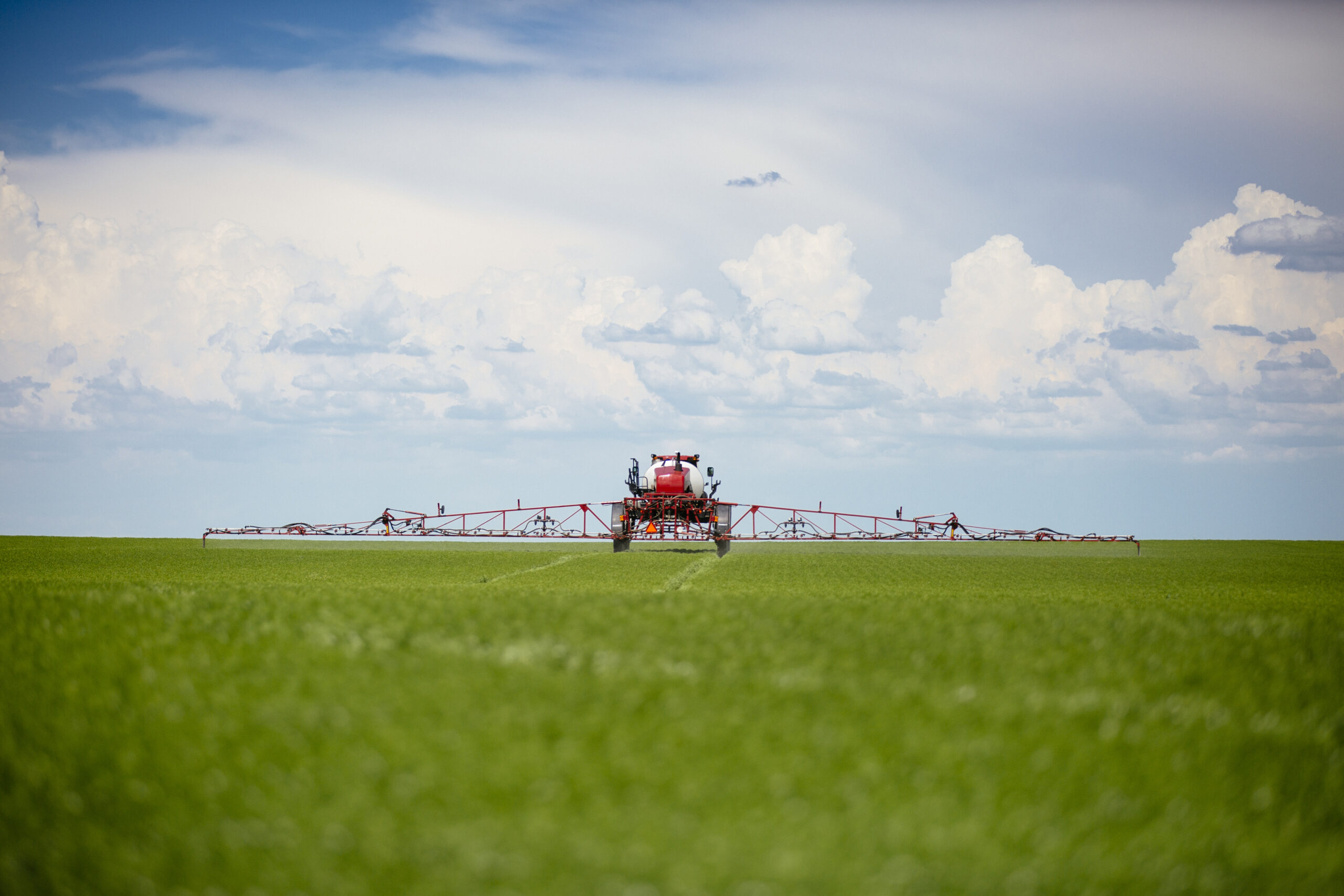
Post-Emergent Herbicide Options for Field Peas
Disease Management
Pea crops are subject to a number of diseases that can reduce yield and quality. Infection can come from a variety of sources. Seed-borne, soil-borne, and residue-borne diseases can be minimized through preventative management. Disease prevention recommendations include:
- Use of effective crop rotations. Plant peas only once every four years in the same field. Continuous production of broadleaf crops can increase some seedling diseases and Sclerotinia.
- Use of the best seed available. A seed test will indicate the presence of seed-borne diseases.
- Use of a registered fungicide seed treatment may be warranted, especially if seeding early into cool, wet soils.
- Use varieties with disease resistance, such as powdery mildew resistance.
- Early seeding.
- Monitoring of fields for diseases.
This fungal disease is a common and economically significant foliar disease of peas in Saskatchewan. It is one of the Ascochyta diseases often referred to as the Ascochyta disease complex. Three Ascochyta species infect peas and are hard to distinguish from each other. In Saskatchewan, the most common species is Ascochyta pinodes. The sexual stage of this species is Mycosphaerella pinodes and is the reason this disease is also referred to as mycosphaerella blight. Losses attributed to this disease have been reported as high as 80 per cent.
The other fungi involved in this complex are Ascochyta pinodella, causing foot rot and Ascochyta pisi causing leaf and pod spot. Ascochyta pisi has been considered a minor problem in the past but appears to becoming more common in the last few years.
Most Ascochyta symptoms observed in the field will be those of mycosphaerella blight. Early symptoms first appear as small, purplish-brown, irregular shaped spots on lower leaves, stems, and pods. These spots grow together and spread up the plant. Infection at the base of the plant may lead to girdling of the stem near the soil line, which is known as foot rot. Girdling weakens the stem and often results in premature lodging. The impact on yield depends on the timing of initial infection and on weather conditions. Early infection followed by wet conditions may lead to higher potential losses.
Infested crop residue is the primary source of infection. Infected seed is not considered a major source of inoculum but may play a role in introducing the disease to new areas. Mycosphaerella pinodes is the only Ascochyta species that forms a sexual spore stage. Those spores result in airborne ascospores allowing transmission of the disease over longer distances. Also, the fungus is capable of living in the soil for long periods of time. This means extended crop rotations do not guarantee low levels of this disease, although it is still an important component of managing Ascochyta and other diseases. No commercial pea varieties are resistant to mycosphaerella blight, but some are more susceptible than others.
Scouting early and monitoring the disease is critical for control. If symptoms move upward in the plant canopy beyond the lower third of the plant, a fungicide application may be warranted. Maximum effectiveness of the fungicide occurs if applied at early flowering. Thorough penetration of the canopy with good leaf coverage is essential. Fungicides work by preventing infection of healthy green plant material. It will not repair plant damage that has already occurred. The timing of infection, yield potential of the crop, weather conditions, and value of the harvested seed will all influence the economics of fungicide application.
Are caused by several fungi including Pythium, Rhizoctonia, Botrytis, and Fusarium species. These soil-borne fungi can attack any part of the root system up to a short distance above the soil surface and can attack any time between germination and maturity. Young seedlings may not emerge, and if they do, they will usually appear yellow and stunted, often dying at an early stage. These fungi are common in the soil, and infection is more likely if the soil around the seed is excessively wet. Warm and moist conditions generally favour these diseases, but cold and wet soil is also detrimental because the cool temperatures slow plant development and add additional stress to the plant.
Numerous products are registered for seed treatment in peas. Seed treatments offer protection to the developing seedling, especially under cool, wet conditions when emergence may be delayed. Seed treatments can reduce the viability of nitrogen-fixing Rhizobium inoculants. Fungicide seed treatments should be applied, allowed to dry, and then the inoculant should be applied just prior to seeding. Granular inoculant is not typically affected by fungicides.
Root rot can also be caused by Aphanomyces species. Aphanomyces euteiches has been identified across most of Saskatchewan. Although some seed treatments are rated for suppression there are no seed treatments that control A. euteiches and it can survive in the soil for many years. It is the most difficult pathogen among the root rot pathogens and is most aggressive under wet conditions.
Although widespread across Western Canada, powdery mildew is now rarely of significance because most grown varieties of peas are resistant to this disease. Without this built-in resistance, yield losses can be high (more than 60%).
Infection of susceptible pea varieties usually begins about mid-to-late July. By this time pea crops seeded in early spring have often progressed past the stage of economic impact, since pods and seeds are already formed. Delayed seeding of susceptible varieties increases the risk of an economic impact.
Powdery mildew thrives under warm and dry daytime conditions with nights that are cool enough to cause dew formation. Rain showers disrupt the spread of powdery mildew. Symptoms include the development of white, powdery spots on lower leaves, and stems that can quickly spread to the entire plant. Severely affected crops are covered in a white mat of powdery spores and may appear to have a bluish or silvery sheen. The undersides of infected leaves turn yellow below the powdery infection. The disease can reduce yield, delay maturity, and reduce uptake of desiccants. If fungicides are required, application should take place at the onset of symptoms.
Variety resistance is the best management strategy. Varieties can no longer be registered in Canada for production in Western Canada unless they have powdery mildew resistance.
Sclerotinia stem rot attacks many broadleaf crops and is usually more severe on sunflowers, dry beans, and canola, compared to peas. It overwinters as sclerotia, small, black resting bodies in the soil, apart from the host. Sclerotia may remain viable for three to five years.
Infection can take place in two ways. When in close contact with the pea root, sclerotia may germinate and cause infection at the base of the plant. Under a dense plant canopy, sclerotia will germinate and develop tiny mushroom like structures that produce spores. These spores colonize dead plant material such as fallen flower petals or hail damaged leaves. Spores can be scattered by the wind, so planting peas next to previously infected fields can assist in spreading the disease.
Once infection has occurred, it can spread very quickly by plant-to-plant contact, especially when there is moisture under a heavy crop canopy. If infection occurs late in the growing season, there may be little effect on yield, however, the buildup of sclerotia in a field may have a negative impact on subsequent broadleaf crops. There are fungicides registered to protect the pea plants from sclerotinia infection. Once symptoms are noted in a pea crop, it is too late to apply a fungicide. Fungicide application must be based on a forecast of risk.
Downy mildew fungal disease is common but does not usually cause serious losses unless cool, wet, and humid conditions exist. Alberta has been having increased problems with this disease, and it is increasing in importance in Saskatchewan. Symptoms show fluffy, greyish growth on the undersides of leaves that may cover the entire leaf underside surface. The top of the leaf becomes yellow and brown opposite to the infected area. Systemic infection, resulting from spores in the soil or on infected seed, causes stunting and distortion. The secondary disease cycle of plant to plant spread originates from these stunted plants and is favoured by moist weather. A two-to-three-year rotation will reduce the soil-borne inoculum but will not completely eliminate it as spores can be long lived in the soil, sometimes over 10 years. Presently, there are a few products registered for suppression, but no fungicides registered to control downy mildew.
Other fungal diseases of minor importance include bacterial blight, Anthracnose, Septoria blight, and rust. Virus-like diseases can also occur in peas. Except for pea seed borne mosaic virus (PSbMV), they are spread by aphids.
Managing Fungicide Resistance
As with herbicides and weed resistance, managing fungicide use to prevent or slow the development of fungicide resistance is in the long-term interests of all pea growers. Use foliar fungicide only when disease risk and potential loss are economically damaging (ex. greater than the cost of control).
Development of resistance of several fungal pathogens to the strobilurin group of fungicides in has been reported in Western Canada. No more than two applications per year of any strobilurin fungicide should be made to the same field, as disease resistance could develop. The continuous use of strobilurin fungicides without fungicide rotation greatly increases the threat of disease resistance.
Any fungal pathogen population may contain some strains naturally insensitive to various fungicides. A gradual or total loss of disease control may occur over time if these fungicides are used repeatedly in the same fields.
The following strategy should be considered and implemented to delay fungicide resistance/insensitivity:
- Use a fungicide rotation – rotate the use of fungicides with others from different groups that control the same pathogens.
- Tank mix fungicides that have a high risk of developing insensitivity with other fungicides from a different group.
- Do not apply more than the maximum number of applications listed on the label. Avoid consecutive sprays of the same fungicide, or other fungicides in the same group, in a season. Fungicides belonging to the strobilurin group should not be applied more than twice a season in the same field.
- Fungicide application should be based on an integrated pest management (IPM) program that includes scouting and accurate recording related to pesticide use and crop rotation.
- Monitor treated fungal populations for signs of fungicide insensitivity. If disease continues to progress after treatment with a product, do not increase the use rate. Discontinue use of the product and switch to another fungicide with a different target site of action.
Related Resources
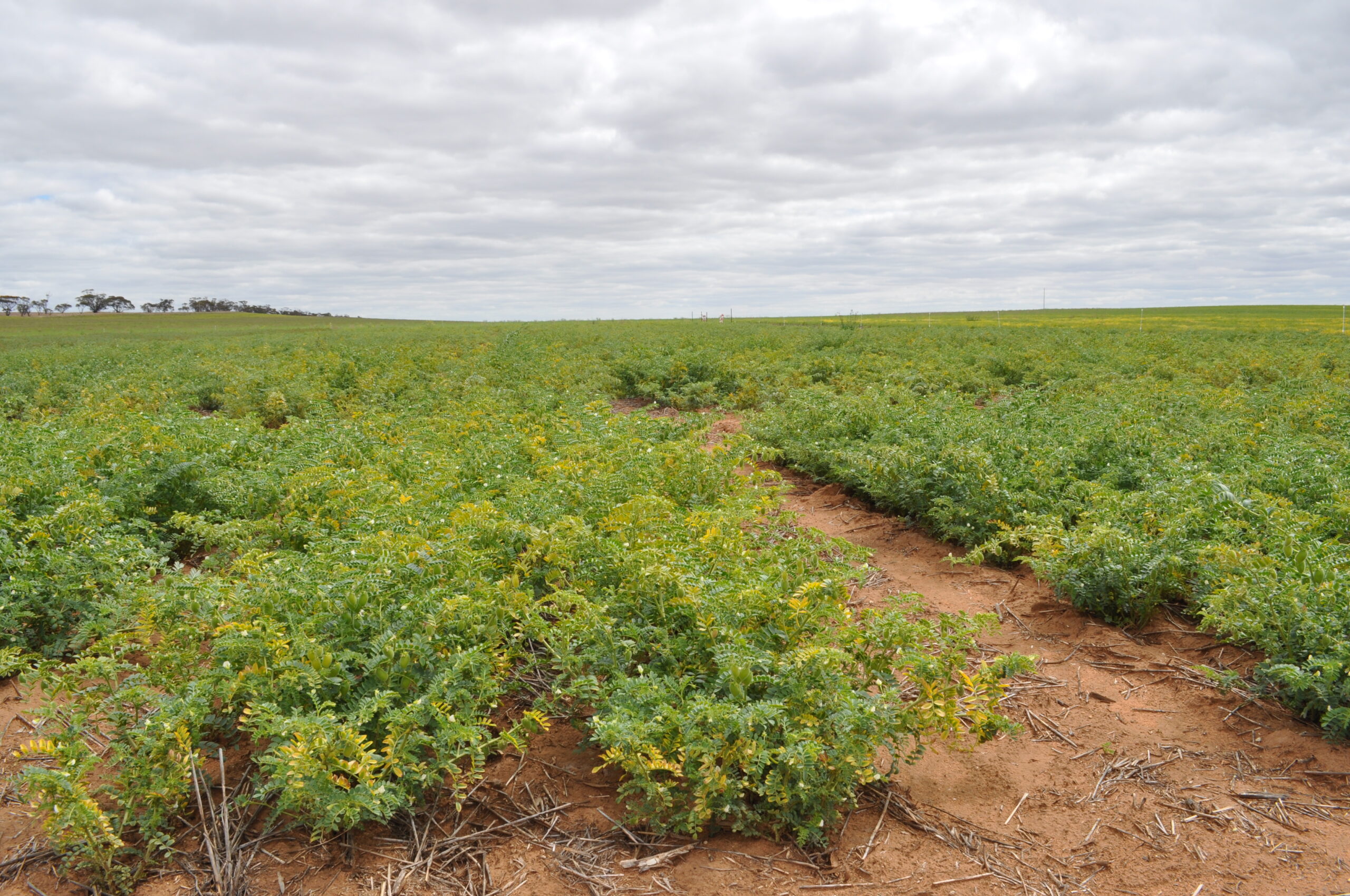
Viruses in Saskatchewan Pulse Crops
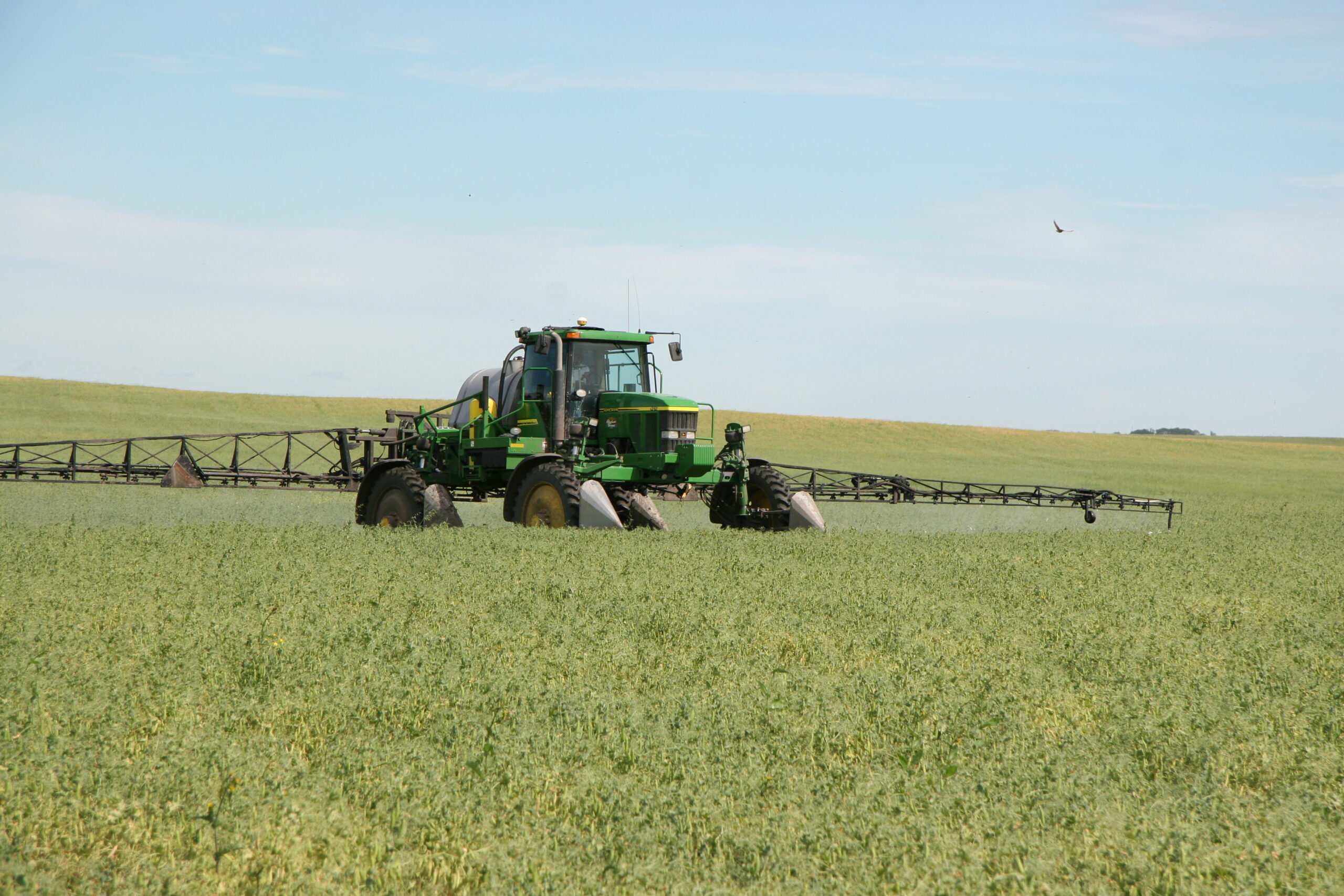
Field Pea Fungicide Options
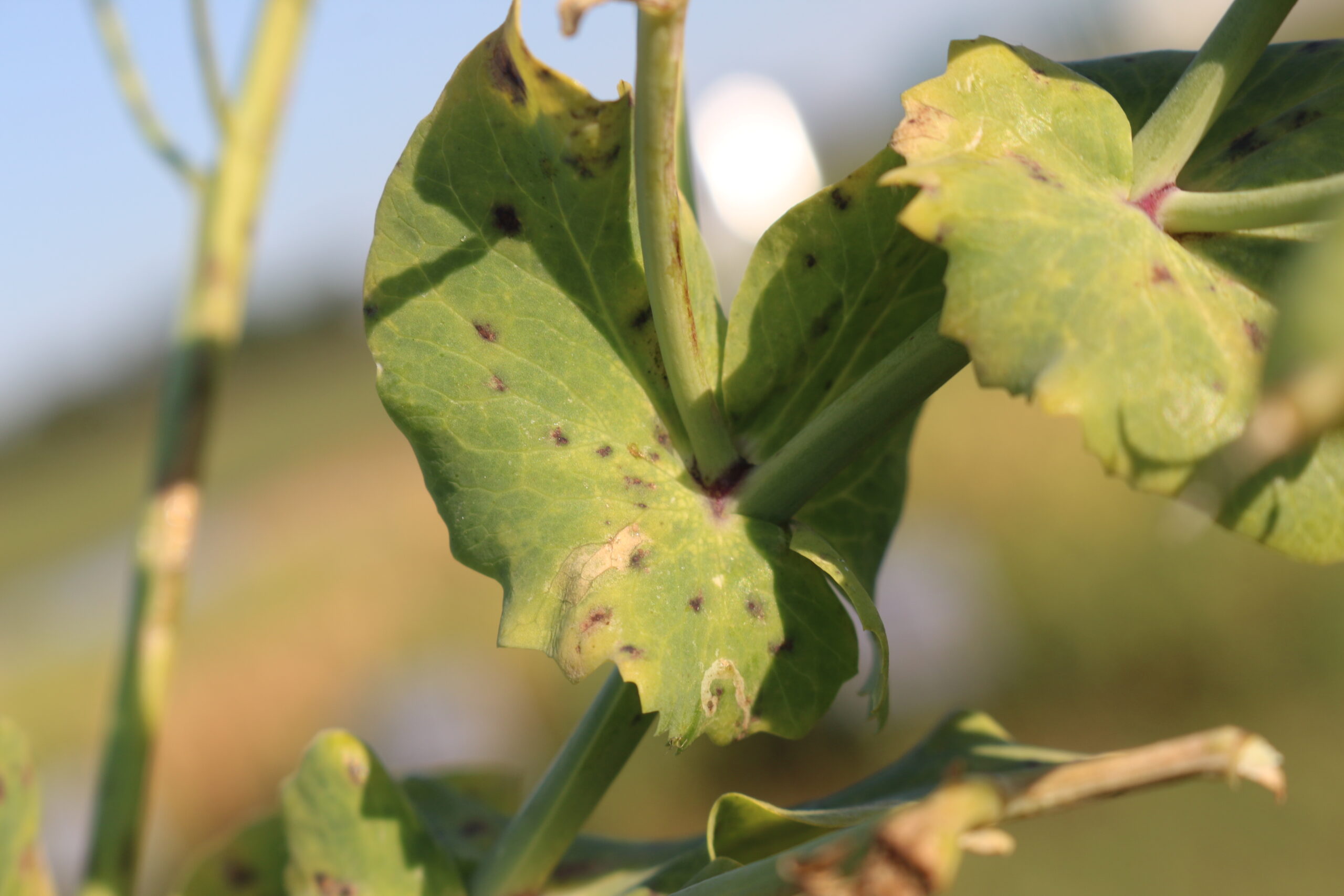
Fungicide Decision Support Checklist for Peas
Insect Management
Pea crops have relatively few insect pests of economic importance, but the few that can affect pea plants must be monitored to prevent yield loss.
The pea aphid is recognized as a yield-threatening pest in peas. The pea aphid weakens the plant directly by sucking its sap, and in warmer countries, is responsible for transmitting virus diseases. The population must reach threshold levels prior to the plant nearing maturity to cause damage. The pea aphid arrives in June to July on winds from the United States. If it arrives early enough and the environment is conducive for rapid reproduction, multiple generations of the insect may eventually result in numbers high enough to cause economic loss. The economic threshold in peas at $0.21/kg ($5.71/bu), and average control cost of $16.63 to $22.86/ha ($6.73 to $9.25/ac) is two to three aphids per 8 in (20 cm) plant tip, or nine to 12 aphids per 180° sweep of a 38 cm net, at flowering. Economic thresholds are also based on when few natural predators are present and aphid numbers do not decline over a two-day period. If most of the pea seeds are close to full size, the aphid is less likely to cause significant damage. Economic loss can occur if there are more than 10 aphids per plant during the period between formation of the tenth node, and the appearance of the first flower. Population estimates should be calculated by averaging the counts taken from at least five separate areas of the field. To avoid a reoccurrence of the problem after spraying, delay application of insecticide until late flowering. One application per season should give satisfactory control. Pea aphid populations usually begin to decline in mid-to-late August due to drying of the crop, parasitic wasps, diseases, and other factors. Insecticides are registered to control aphids on peas. Insecticides with both contact and systemic action can be advantageous.
The pea leaf weevil has been expanding its infestation eastward across southern Saskatchewan. The grey adult weevil feeds on pea seedlings leaving scalloped or notched leaf margins in seedlings. The adult is difficult to observe, therefore economic thresholds are determined by the severity of notches in plants at various points in the field. Usually, pea plants will survive this defoliation, however, adult females will lay large numbers of eggs at the base of pea plants. The larvae hatch and burrow into the soil causing more serious damage when they feed on nitrogen fixing nodules on the roots of the plant. Research at AAFC-Lethbridge, Alberta, suggests the best yield response from insecticides results from the use of a seed treatment. If a foliar application is required, the current threshold for insecticide application is one notch per three clam leaf pairs (the most recently emerged leaves), or one-third of plants exhibiting feeding damage prior to the sixth node stage of crop growth.
The pea leaf weevil produces one generation per year. The adult (light grayish brown colour with three stripes on the back and on the wings) overwinters in alfalfa, other perennial legumes, or tree shelters. In May through June, eggs are laid on-or-near developing pea plants. The adult moves (up to a few kilometers) mainly by flying when temperatures are above 17°C but can also walk short distances. The larvae hatch in one to three weeks, and feed on the nodules on the roots. Once the larval stage is complete, the insect pupates and emerges as an adult once again in late July through September. It will search for any legume plants, including peas and other pulse crops, and continue to feed until it finds an overwintering spot.
Cutworms can cause damage to newly emerged pea seedlings, and at times may require insecticide application. Below-ground feeding cutworms (pale western and red-backed cut worms) cut plants off at-or-near the soil surface. Foliar feeding cutworms (dingy and army cutworms) feed above-ground, consuming the plant foliage. Pea crops can often recover from cutworm damage if cool, moist growing conditions occur. However, plants are set back and may not be competitive.
Fields should be monitored from late May to late-June. The economic threshold for cutworms is two to three per square metre (0.2 to 0.3/ft2) in the top 7.5 cm (three inches) of soil. Insecticides that are currently registered for the control of cutworms are listed in the Guide to Crop Protection. Best control, if using an insecticide with contact mode of action, is achieved by applying in the evening, due to cutworm nocturnal feeding habits.
Peas are not a preferred food source for grasshoppers, but they will feed on pea plants if no other food source is available. Damage is most likely to be seen along ditches and road allowances. Usually, grasshopper infestations of 10/m2 and less do not cause economic losses in peas. Insecticides are registered for the control of grasshoppers in peas.
This insect tends to be more abundant in moist soils and in lower, damper areas of a field. They are the immature stage or larvae of click beetles. Although wireworms prefer grassy plants (cereal crops), wireworm damage has been noted in other crops including canola, chickpeas, and potatoes. Wireworms tend to shred the plant tissue below the soil surface. Initially, symptoms may show up as wilting in the central leaves of the main stem but can eventually cause death of the plant. Damage may not be noticed early enough in the season to reseed. There is no established economic threshold for wireworm in peas and there is no in-crop insecticide available to control wireworm. Controlling wireworm requires the use of insecticidal seed treatment.
